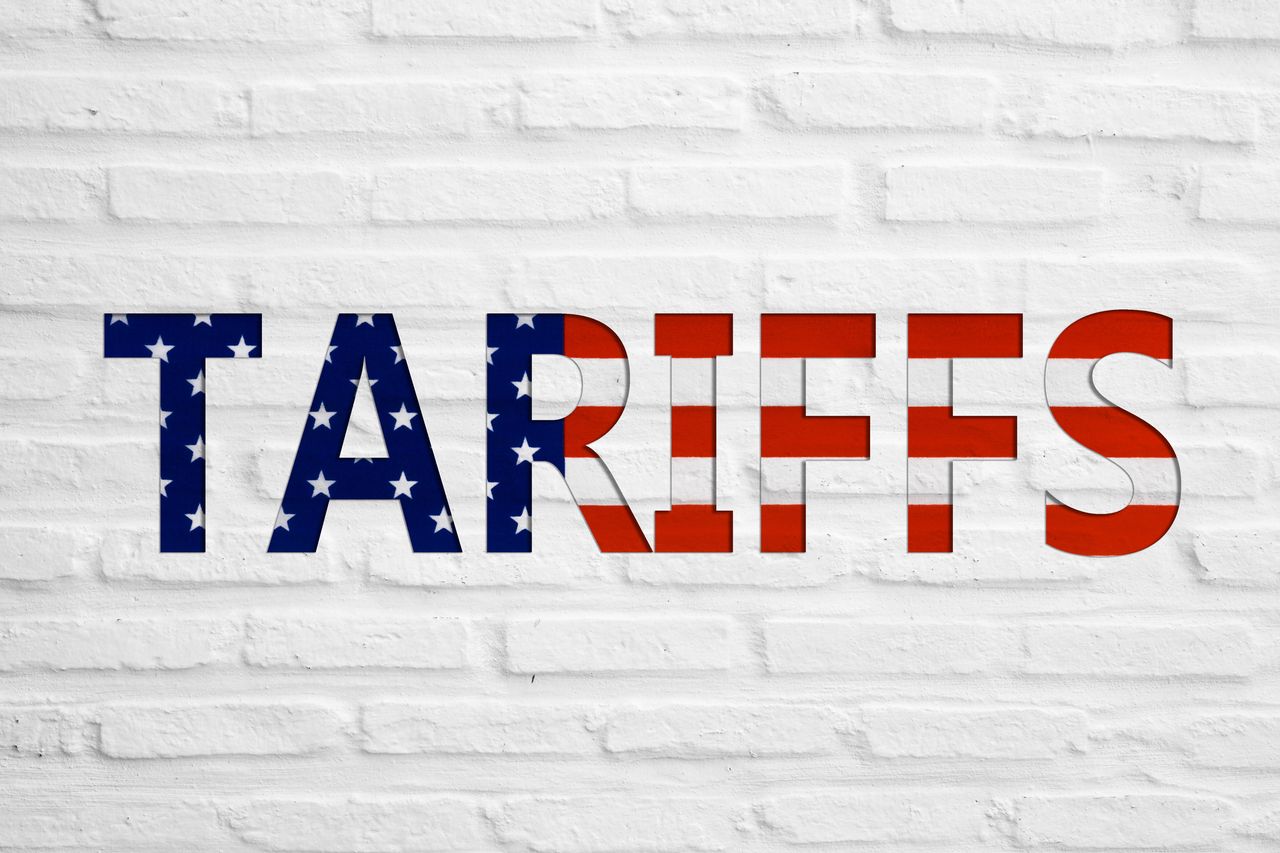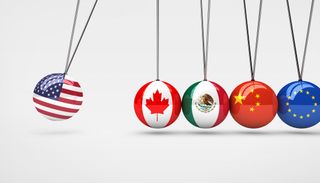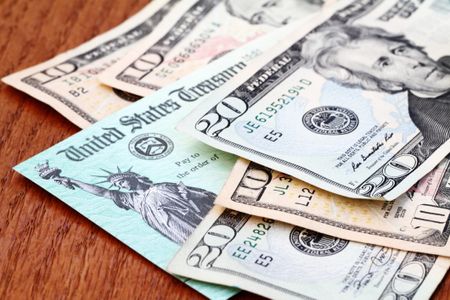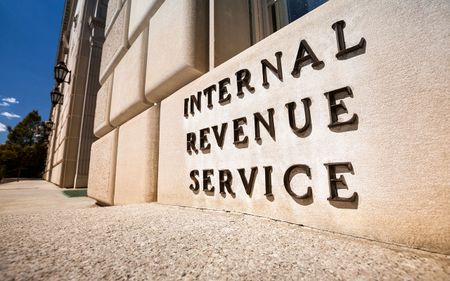What’s Happening With Trump Tariffs? Updates for April 2025
Donald Trump continues to use tariffs as a central tool of his trade policy. Here’s where tariffs stand now.


You've probably noticed that President Donald Trump is making tariffs a central part of his economic strategy. He argues that these taxes on imported goods and services are crucial for reducing the United States trade deficit and enhancing U.S. manufacturing.
On April 2, an event was held in the White House Rose Garden, where Trump announced sweeping tariffs on nearly all products imported from several countries. (More on that below.)
However, many economists argue that Trump’s tariff policies will harm the U.S. economy by increasing costs for businesses and consumers, exacerbating inflation, and potentially slowing economic growth.

Sign up for Kiplinger’s Free E-Newsletters
Profit and prosper with the best of expert advice on investing, taxes, retirement, personal finance and more - straight to your e-mail.
Profit and prosper with the best of expert advice - straight to your e-mail.
In a recent CBS interview, investor and philanthropist Warren Buffett described tariffs as "an act of war, to some degree."
When will Trump's tariffs start?
Still, since the start of Trump’s second term in office, he has threatened, implemented, or paused broad tariffs on various goods, including steel, aluminum, cars, and more. The measures target countries like China and important trading partner allies, including Canada and Mexico.
As Kiplinger has reported, Trump has said he’d like to eliminate income taxes in favor of tariffs and establish an ERS (External Revenue Service) to collect tariff revenues.
With new tariffs scheduled to take effect on April 3, aimed at automobiles and other imports, near what Trump dubbed "Liberation Day" and "Economic Independence Day," trade tensions are heightened.
The inconsistent nature of some of these tariff decisions has also unsettled markets and caused confusion. Stock futures fell sharply following Trump's announcement of the new tariffs.
Meanwhile, several GOP senators may reportedly join Democratic Sen. Tim Kaine of Virginia's resolution to block Trump's tariffs on Canadian imports.
It can be a lot to keep track of. So, here is more information about the various Trump tariffs, starting with the latest levies, to help keep you up to date.
Latest Developments
Tariff News
Here’s where things stand so far with Trump’s tariffs. (More detailed information on each is provided below.)
- April 2, 2025: Trump's Tariff' Liberation Day": Trump announces sweeping tariffs on more than 15 countries at half the rate the administration claims they charge the U.S.
- March 26, 2025: President Trump announces a 25% tariff on almost all imported cars to be effective as of April 3, 2025, and on key auto parts planned for May 3.
- March 12, 2025: The U.S. announces Increased tariffs on steel and aluminum to 25% globally.
- March 4, 2025: Trump increased tariffs on Chinese imports to 20%.
- Ongoing: Trump hints at upcoming tariffs on lumber and pharmaceuticals.
Retaliatory measures by trade partners
Global trading partners have responded strongly to Trump's tariff policies:
- Canada & Mexico: Both countries are reportedly negotiating exemptions under the USMCA framework but remain concerned about broader impacts.
- European Union: EU officials are preparing countermeasures while signaling some openness to negotiations with the U.S.
- China: Beijing has criticized the new measures and hinted at potential retaliatory actions.

Auto import tariffs
Trump announced a 25% tariff on all imported cars and auto parts. Trump says the tariffs will take effect April 3. (May 3 is when tariffs go into effect on key auto parts, e.g., engines, transmissions, and electrical systems.)
Vehicles and parts originating from Canada and Mexico that comply with the United States-Mexico-Canada Agreement (USMCA) will initially be exempt until a system is established to levy tariffs on non-U.S. components.
Meanwhile, on Saturday, Trump told NBC News he "couldn't care less" if foreign automakers raise prices due to the levies. Trump says Americans will simply buy cars made in the United States.
- The Tax Foundation and other organizations have analyzed the potential impact of various trade policies, including tariffs on imported goods.
- Those analyses suggest that tariffs on automobiles and auto parts would lead to higher consumer prices. However, the specific dollar amount would depend on the size and scope of the tariffs.
Additionally, Trump has recently hinted at upcoming tariffs targeting lumber, pharmaceuticals, and other sectors, signaling further escalation in trade measures.
Reciprocal tariffs announced
In what he dubbed "Economic Independence Day," Donald Trump announced sweeping new reciprocal tariffs on more than 15 countries.
During an April 2 event in the White House Rose Garden, Trump held up a chart listing the countries, their tariff rates, and the proposed new U.S. tariff rate.
For example, the administration says China charges 67% so that the U.S. will impose a 34% tariff. The U.S. will have a minimum baseline tariff of 10% on almost all goods, the same rate that will apply to the UK. The EU will be subject to a 20% tariff.
The list included a 46% tariff on Vietnam, 24% on Japan, a 25% tariff on South Korea, and 31% on Switzerland.
In a developing story, Trump described these numbers as "kind reciprocal, not full reciprocal."
Pharmaceutical tariffs?

Trump says he will soon announce tariffs on imported pharmaceuticals.
“We have to bring pharmaceuticals, drugs, and pharmaceuticals back into our country. We never want to have to rely on other countries for that,” Trump said to reporters on March 29, captured in an Associated Press video.
Trump has suggested such tariffs could be as high as 25%, and could impact pharmaceutical products from China, Europe, Canada, and Mexico. However, the exact percentage, timing, and scope remain unclear.
Tariff Status by Country
United States tariffs
- 25% on imported cars (effective April 3, 2025) and key auto parts (May 3)
- 25% on steel and aluminum (effective March 12, 2025)
- 20% on Chinese imports (effective March 4, 2025)
- 25% on most Canadian and Mexican goods (with USMCA exemptions until April 2, 2025)
As mentioned, tariffs are a central component of Trump's economic strategy in his second term as President. He's expanded levies on imports from China, Canada, Mexico, and the European Union, covering goods ranging from steel and aluminum and cars to agricultural products.

Canada tariffs on US
- 25% on CA$30 billion of U.S. goods (March 4, 2025)
- An additional 25% on CA$29.8 billion of U.S. products (March 13, 2025)
Since Trump began his second term in January 2025, trade tensions between the U.S. and Canada have escalated significantly due to new tariff measures.
In early March, the Trump administration introduced a sweeping 25% tariff on most Canadian imports, with energy products facing a reduced rate of 10%. These actions have strained existing agreements and prompted sharp criticism from Canadian leaders.
New Canadian Prime Minister Mark Carney responded with retaliatory tariffs of 25% on $30 billion worth of U.S. goods. Those tariffs target key U.S. exports like orange juice, peanut butter, and motorcycles.
If the dispute continues, Canada has warned it could expand these tariffs to cover $155 billion in U.S. goods.
While recent talks between Trump and Carney on March 28 showed some willingness to engage diplomatically, the outlook is uncertain.
Mexico tariffs
- 25% on most Mexican goods is said to go into effect March 4, 2025, with USMCA exemptions paused until April 2, 2025
On February 1, Trump signed executive orders imposing a 25% tariff on all imports from Mexico, including energy products, which were excluded from the reduced rates granted to Canada. Some tariffs took effect on March 4, despite earlier negotiations for a one-month delay.
Mexican President Claudia Sheinbaum strongly condemned the tariffs as unjustified and harmful.
In response, Mexico announced plans for retaliatory measures, including tariffs and non-tariff restrictions. While details remain unclear, Sheinbaum hinted at a comprehensive strategy targeting key U.S. exports and industries.
The U.S. justified the tariffs as efforts to address border security and reduce trade deficits, but Mexico has argued that they violate the USMCA.
Some economists warn that the actions could disrupt supply chains and increase consumer prices across North America.
Although diplomatic talks continue, tensions remain high as both countries brace for economic fallout from this escalating trade conflict.
China tariffs on US
- 10-15% on U.S. meat and agricultural products (March 10, 2025)
- Suspension of U.S. lumber imports and revocation of soybean import licenses
- 15% on coal and liquefied natural gas, 10% on oil and agricultural machines (February 4, 2025)
On February 4, 2025, the U.S. imposed a 10% tariff on all Chinese imports under the International Emergency Economic Powers Act (IEEPA). That was doubled to 20% on March 4, following a Trump executive order to address national security concerns.
In response, China announced retaliatory tariffs effective March 10, including a 15% duty on U.S. chicken, wheat, corn, and cotton and a 10% duty on sorghum, soybeans, pork, beef, seafood, fruits, vegetables, and dairy products.
Additionally, China suspended export permits for certain U.S. soybean producers and restricted imports of dual-use technologies from American companies.
Beyond tariffs, China has reportedly employed non-tariff measures like adding U.S. firms to its "Unreliable Entity List" and launching investigations into American products.
Despite some diplomatic overtures, the trade conflict remains unresolved. And on March 31, according to Chinese state media, China, Japan, and South Korea are planning a joint response to U.S. tariffs.
EU tariffs
- Proposed tariffs on €4.5 billion of U.S. consumer goods and €18 billion of U.S. steel and agricultural products (expected mid-April 2025)
U.S.- European Union (EU) trade relations have been strained by Trump's escalating tariff disputes.
On February 10, 2025, the Trump administration imposed a 25% tariff on steel and aluminum imports from the EU, along with additional duties on derivative products. In response, the European Union announced a two-phase retaliatory plan targeting approximately €26 billion ($28 billion) worth of U.S. exports.
In an April 2 announcement, Trump said the U.S. will impose at 20% tariff on the EU.
- Phase one involves reinstating tariffs from 2018 and 2020, which had been suspended under President Biden.
- Phase two introduces new tariffs on agricultural products, alcoholic beverages, textiles, and household items.
- Originally scheduled to begin on April 1, both phases were delayed to mid-April for further negotiations.
The EU’s countermeasures include tariffs as high as 50% on motorcycles, bourbon whiskey, poultry, and beef. European Commission President Ursula von der Leyen emphasized the bloc’s willingness to negotiate but warned of economic risks posed by tariffs on both sides.
Meanwhile, Trump has threatened additional measures, including a 200% tariff on European alcoholic products.
As the April deadline approaches, both parties remain locked in tense trade policy discussions.
Tariff Product Breakdown
Here is an overview of significant tariffs currently implemented under President Trump's administration:
Trump tariffs in 2025
Product | Country | Tariff Rate | Effecctive Date |
|---|---|---|---|
Automobiles | Global | 25% | April 3 |
Steel | Global | 25% | March 12 |
Aluminum | Global | 25% | March 12 |
Agricultural | Various | TBD | Threatened: April 2 |
Tariff Impact
Economic impacts of Trump tariff policies: Groceries, Cars, Inflation
The economic consequences of Trump’s tariffs are becoming increasingly evident:
Automotive Industry: Some analysts estimate that the new auto tariffs could add $3,000 to the cost of U.S.-manufactured vehicles and $6,000 to those made in Canada or Mexico without exemptions. Production output could drop by as much as 30%, equating to a reduction of approximately 20,000 vehicles per day.
Inflation Concerns: Economists warn that higher tariffs could exacerbate inflation as manufacturers pass increased costs onto consumers.
As reported by Kiplinger, tariffs function as taxes on imports, which raise prices for goods like electronics, clothing, and food, disproportionately affecting lower-income households and reducing purchasing power.
According to the Yale Budget Lab, these higher costs could lead to slower GDP growth, with estimates suggesting a 0.6% reduction in 2025 and long-term economic losses equivalent to $80–110 billion a year.
Employment: While some sectors, like steel manufacturing, have seen job growth, others that rely on imported components face layoffs and reduced production capacity.
Additionally, some businesses are reportedly scaling back hiring and investment plans due to uncertainty and increased operational expenses.
Trade War: Bottom Line
Tariffs: What's next?
Here are some things to watch as the trade wars continue.
On April 2, reciprocal tariffs targeting additional countries and sectors will likely be announced. These measures could expand the scope of existing trade conflicts.
- The Trump administration may use tariff threats as leverage in bilateral talks with trading partners like Canada and Mexico under the USMCA framework.
- Industries like pharmaceuticals and lumber could face tariffs.
- China, Japan, and South Korea are reportedly planning a joint response to Trump's tariffs.
- Due to President Trump's tariff policies, U.S. consumers will likely face higher prices on a wide range of goods.
Automobiles may become significantly more expensive, with new car prices rising by thousands of dollars and repair costs increasing due to tariffs on imported parts.
Furniture, electronics, household items from China, fresh produce from Mexico, and steel-based products are also expected to see price hikes as import duties take hold.
These tariffs are also projected to contribute to inflation, making everyday goods more costly for U.S. households. Stay tuned.
This article has been updated to reflect recent announcements from the White House regarding tariffs.
Related Content
Get Kiplinger Today newsletter — free
Profit and prosper with the best of Kiplinger's advice on investing, taxes, retirement, personal finance and much more. Delivered daily. Enter your email in the box and click Sign Me Up.

As the senior tax editor at Kiplinger.com, Kelley R. Taylor simplifies federal and state tax information, news, and developments to help empower readers. Kelley has over two decades of experience advising on and covering education, law, finance, and tax as a corporate attorney and business journalist.
-
 Stock Market Today: Stocks Are Mixed Before Liberation Day
Stock Market Today: Stocks Are Mixed Before Liberation DayMarkets look forward to what comes with the reordering of 80-year-old global trade relationships.
By David Dittman Published
-
 Stagflation: What It Is and Why Retirees Should Care
Stagflation: What It Is and Why Retirees Should CareStagflation — the economic bogeyman of the 1970's — may return to the US. Here's what it could mean to your retirement.
By Donna Fuscaldo Published
-
 ‘Are You Better Off Than You Were 71 Days Ago?’ Cory Booker Historic Senate Speech Highlights Tax Debate
‘Are You Better Off Than You Were 71 Days Ago?’ Cory Booker Historic Senate Speech Highlights Tax DebateTax Policy A speech protesting Trump’s policies, including tax plans, breaks U.S. Senate records.
By Kelley R. Taylor Last updated
-
 New South Carolina Income Tax Cut Might Eat Your Cash
New South Carolina Income Tax Cut Might Eat Your CashState Taxes South Carolina’s flat income tax bill could have the majority of residents paying higher income taxes. Find out how.
By Kate Schubel Published
-
 Taxpayer Revolt? Why More People Are Avoiding Filing Taxes This Year
Taxpayer Revolt? Why More People Are Avoiding Filing Taxes This YearTax Season It may be tempting to skip filing due to the overwhelmed IRS, but doing so could have financial and legal consequences.
By Kelley R. Taylor Last updated
-
 U.S. Treasury to Eliminate Paper Checks: What It Means for Tax Refunds, Social Security
U.S. Treasury to Eliminate Paper Checks: What It Means for Tax Refunds, Social SecurityTreasury President Trump signed an executive order forcing the federal government to phase out paper check disbursements by the fall.
By Gabriella Cruz-Martínez Published
-
 IRS Layoffs Spark Delays, Doubt This Tax Season
IRS Layoffs Spark Delays, Doubt This Tax SeasonTax Season Tax experts say Trump’s downsizing of the IRS is already causing problems.
By Gabriella Cruz-Martínez Last updated
-
 DOGE Gains More Grip on IRS Amid Leadership Reshuffle
DOGE Gains More Grip on IRS Amid Leadership ReshuffleIRS The IRS acting chief counsel was recently removed from his role, adding to the chaos at the federal tax agency. Here’s what it means for you.
By Gabriella Cruz-Martínez Published
-
 Will Your State End Tax on Tips This Year?
Will Your State End Tax on Tips This Year?State Tax While President Trump spearheads federal talk on tips, several key states are considering ending taxes on tip income.
By Kate Schubel Published
-
 Trump’s Latest Pitch: No Taxes If You Earn Less Than $150K?
Trump’s Latest Pitch: No Taxes If You Earn Less Than $150K?Taxes The Trump administration reportedly wants to eliminate taxes for certain earners.
By Gabriella Cruz-Martínez Last updated